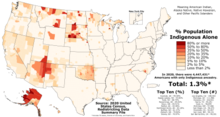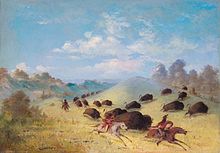
Native Americans in the United States
Indigenous peoples of the United States / From Wikipedia, the free encyclopedia
Dear Wikiwand AI, let's keep it short by simply answering these key questions:
Can you list the top facts and stats about Native Americans in the US?
Summarize this article for a 10 years old
Native Americans, sometimes called First Americans or Indigenous Americans, are the Indigenous peoples of the contiguous United States and Alaska. They include American Indians and Alaska Natives. The United States Census Bureau defines Native Americans as Indigenous tribes that are originally from the contiguous United States and Alaska Natives. There are 574 federally recognized tribes living within the U.S., about half of which are associated with Indian reservations.
 Proportion of Indigenous Americans in each county of the 50 states, Washington, D.C., and Puerto Rico as of the 2020 census | |
| Total population | |
|---|---|
| American Indian and Alaska Native (2020 census)[1][2] One race: 3,727,135 are registered In combination with one or more of the other races listed: 5,938,923 Total: 9,666,058 ~ 2.9% of the total U.S. population. | |
| Regions with significant populations | |
| Predominantly in the Western United States; small communities also exist in the Eastern United States | |
| Languages | |
| English Native American languages (including Navajo, Central Alaskan Yup'ik, Tlingit, Haida, Dakota, Seneca, Lakota, Western Apache, Keres, Cherokee, Choctaw, Creek, Kiowa, Comanche, Osage, Zuni, Pawnee, Shawnee, Winnebago, Ojibwe, Cree, O'odham[3]) Spanish Native Pidgin (extinct) French Russian (mostly in Alaska) | |
| Religion | |
| |
| Related ethnic groups | |

Indigenous peoples of Hawaii and territories of the United States are usually known by other terms. Indigenous peoples of the United States who are not listed as American Indian or Alaska Native include Native Hawaiians, Samoan Americans, and Chamorros. The U.S. Census groups these peoples as "Native Hawaiian and other Pacific Islanders".
The European colonization of the Americas that began in 1492 resulted in a precipitous decline in Native American population because of newly introduced diseases (including weaponized diseases and biological warfare by European colonizers[4][5][6][7][8]), wars, ethnic cleansing, and enslavement. After its formation, the United States, as part of its policy of settler colonialism, continued to wage war and perpetrated massacres against many Native American peoples, removed them from their ancestral lands, and subjected them to one-sided treaties and to discriminatory government policies. These later focused on forced assimilation, into the 20th century.[9][10][11]
Since the 1960s, Native American self-determination movements have resulted in positive changes to the lives of many Native Americans, though there are still many contemporary issues faced by them. Today, there are over five million Native Americans in the United States, 78% of whom live outside reservations. The states with the highest percentage of Native Americans in the U.S. are Alaska, Oklahoma, New Mexico, South Dakota, Montana, and North Dakota.[12][13]
When the United States was created, established Native American tribes were generally considered semi-independent nations, as they generally lived in communities separate from white settlers. The federal government signed treaties at a government-to-government level until the Indian Appropriations Act of 1871 ended recognition of independent Native nations, and started treating them as "domestic dependent nations" subject to applicable federal laws. This law did preserve the rights and privileges agreed to under the treaties, including a large degree of tribal sovereignty. For this reason, many Native American reservations are still independent of state law and the actions of tribal citizens on these reservations are subject only to tribal courts and federal law, often differently applicable to tribal lands than to U.S. state or territory by exemption, exclusion, treaty, or superseding tribal or federal law.
The Indian Citizenship Act of 1924 granted U.S. citizenship to all Native Americans born in the United States who had not yet obtained it. This emptied the "Indians not taxed" category established by the United States Constitution, allowed Natives to vote in state and federal elections, and extended the Fourteenth Amendment protections granted to people "subject to the jurisdiction" of the United States. However, some states continued to deny Native Americans voting rights for several decades. Titles II through VII of the Civil Rights Act of 1968 comprise the Indian Civil Rights Act, which applies to the Native American tribes of the United States and makes many but not all of the guarantees of the U.S. Bill of Rights applicable within the tribes (that Act appears today in Title 25, sections 1301 to 1303 of the United States Code).[14]